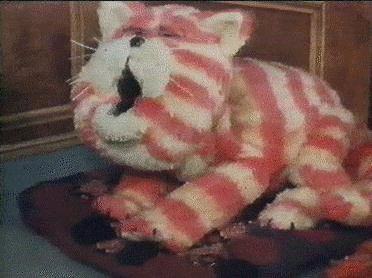Post by Taxigirl on Jan 2, 2004 10:33:03 GMT
 ;D
;DCult children's TV character Bagpuss is 30 years old this year - and there is life in the old cat yet.
He may be just a saggy cloth cat but Bagpuss continues to enjoy the revival that began when he won a BBC poll of the most popular children's TV programme of all time in 1999.
The popular pink and white moggy was invented in 1974 by Peter Firmin and Oliver Postgate, the creative team also behind Pogle's Wood, Ivor the Engine, Noggin the Nog and The Clangers.
Bagpuss and his friends lived in a fictional shop which did not sell anything but was filled with lost items found by seven-year-old Emily, Mr Firmin's real-life daughter.
Only 13 episodes of Bagpuss were made, even though it was on air for 26 weeks a year over 13 years.
But in the past four years, fans of all ages have bought up Bagpuss merchandise by the bucketload, contributing over £30m to the UK economy.
So what is behind the fat furry feline's appeal?
Illustrator Mr Firmin has a simple theory, believing that Bagpuss's unusual appearance is a big part of his success.
"Bagpuss was meant to be marmalade but when I got him back from a local firm, they told me there had been a problem with the chemical process and he had come out pink instead," he says.
"But he looked so distinctive, I decided to keep him that way - it was a marvellous accident really."
Mr Firmin trained at Central Saint Martin's College in London and worked in a stain glass studio before he was approached by Mr Postgate after going freelance.
"Oliver always said I was very scathing of giving up art for TV," he says.
Mr Firmin believes the appetite for nostalgia is also a big factor for Bagpuss fans.

"Children in their 20s and 30s started having their own kids and wanted things to be remembered," he says.
Fran Huxley, who turned Bagpuss into a major high street brand in the late 1990s, agrees.
"To begin with, we were just looking at the nostalgic, retro market, 16 - 34-year-olds with their warm childhood memories," she says.
But she soon noticed that younger people were buying, too.
"Under-16 fashion-conscious girls started buying Bagpuss products such as T-shirts," says Ms Huxley.

Her company, Licensing By Design, has since gone on to launch a "glitter" range for seven-to-16s.
Mr Firmin and Mr Postgate take Bagpuss's trendy appeal in good humour.
"Oliver says Bagpuss is very elderly and dignified - the cat is above all this," says Mr Firmin.
His daughter Emily, now an adult, still remembers having her photograph taken for the part.
"None of my five sisters were jealous, they had appeared in dad's other work, like Pogle's Wood and the Pingwings," she says.
"Being part of the programme is the last thing I tell people about but my friends usually let the cat out of the bag.
" Dad always says Bagpuss is mine but I don't lay any claim to him - cats are very independent creatures."
Bagpuss now resides in his home town at the Rupert the Bear Museum, part of the Museum of Canterbury.
It seems a shame, given all the renewed interest, that only a few episodes were made.
"The contract wasn't renewed after the 13 episodes - puppets were deemed old-fashioned and live action stuff like Playschool was more the thing," says Mr Firmin.
Bagpuss Facts
The first episode was shown on 12 February 1974
Bagpuss is the mascot for the Asthma Association
Bagpuss has sponsored a wing of Romanian orphanage
DVD and video sales have topped the 300,000 mark


